Related Research Articles
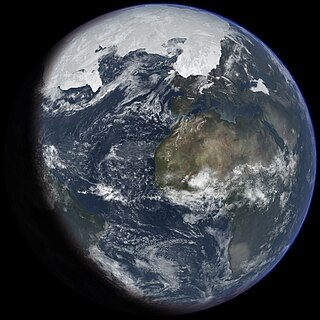
An ice age is a long period of reduction in the temperature of Earth's surface and atmosphere, resulting in the presence or expansion of continental and polar ice sheets and alpine glaciers. Earth's climate alternates between ice ages, and greenhouse periods during which there are no glaciers on the planet. Earth is currently in the ice age called Quaternary glaciation. Individual pulses of cold climate within an ice age are termed glacial periods, and intermittent warm periods within an ice age are called interglacials or interstadials.
The Miocene is the first geological epoch of the Neogene Period and extends from about 23.03 to 5.333 million years ago (Ma). The Miocene was named by Scottish geologist Charles Lyell; the name comes from the Greek words μείων and καινός and means "less recent" because it has 18% fewer modern marine invertebrates than the Pliocene has. The Miocene is preceded by the Oligocene and is followed by the Pliocene.

The Sahara is a desert spanning across North Africa. With an area of 9,200,000 square kilometres (3,600,000 sq mi), it is the largest hot desert in the world and the third-largest desert overall, smaller only than the deserts of Antarctica and the northern Arctic.
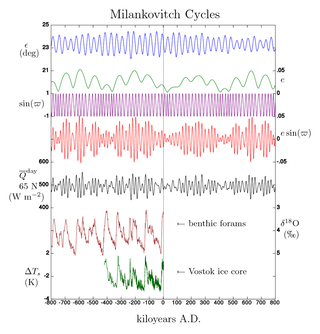
Milankovitch cycles describe the collective effects of changes in the Earth's movements on its climate over thousands of years. The term was coined and named after the Serbian geophysicist and astronomer Milutin Milanković. In the 1920s, he hypothesized that variations in eccentricity, axial tilt, and precession combined to result in cyclical variations in the intra-annual and latitudinal distribution of solar radiation at the Earth's surface, and that this orbital forcing strongly influenced the Earth's climatic patterns.
Orbital forcing is the effect on climate of slow changes in the tilt of the Earth's axis and shape of the Earth's orbit around the Sun. These orbital changes modify the total amount of sunlight reaching the Earth by up to 25% at mid-latitudes. In this context, the term "forcing" signifies a physical process that affects the Earth's climate.
The Holocene Climate Optimum (HCO) was a warm period in the first half of the Holocene epoch, that occurred in the interval roughly 9,500 to 5,500 years BP, with a thermal maximum around 8000 years BP. It has also been known by many other names, such as Altithermal, Climatic Optimum, Holocene Megathermal, Holocene Optimum, Holocene Thermal Maximum, Hypsithermal, and Mid-Holocene Warm Period.
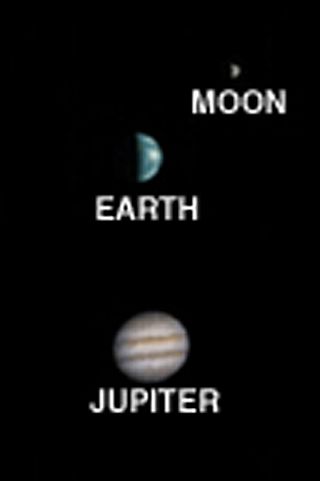
Many astronomical phenomena viewed from the planet Mars are the same as or similar to those seen from Earth; but some are quite different. For example, because the atmosphere of Mars does not contain an ozone layer, it is also possible to make UV observations from the surface of Mars.

An interglacial period is a geological interval of warmer global average temperature lasting thousands of years that separates consecutive glacial periods within an ice age. The current Holocene interglacial began at the end of the Pleistocene, about 11,700 years ago.

The Quaternary glaciation, also known as the Pleistocene glaciation, is an alternating series of glacial and interglacial periods during the Quaternary period that began 2.58 Ma and is ongoing. Although geologists describe this entire period up to the present as an "ice age", in popular culture this term usually refers to the most recent glacial period, or to the Pleistocene epoch in general. Since Earth still has polar ice sheets, geologists consider the Quaternary glaciation to be ongoing, though currently in an interglacial period.
Sapropel is a term used in marine geology to describe dark-coloured sediments that are rich in organic matter. Organic carbon concentrations in sapropels commonly exceed 2 wt.% in weight.

Earth's climate system is a complex system with five interacting components: the atmosphere (air), the hydrosphere (water), the cryosphere, the lithosphere and the biosphere. Climate is the statistical characterization of the climate system. It represents the average weather, typically over a period of 30 years, and is determined by a combination of processes, such as ocean currents and wind patterns. Circulation in the atmosphere and oceans transports heat from the tropical regions to regions that receive less energy from the Sun. Solar radiation is the main driving force for this circulation. The water cycle also moves energy throughout the climate system. In addition, certain chemical elements are constantly moving between the components of the climate system. Two examples for these biochemical cycles are the carbon and nitrogen cycles.
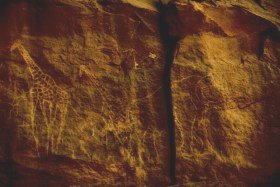
The Sahara pump theory is a hypothesis that explains how flora and fauna migrated between Eurasia and Africa via a land bridge in the Levant region. It posits that extended periods of abundant rainfall lasting many thousands of years in Africa are associated with a "wet-green Sahara" phase, during which larger lakes and more rivers existed. This caused changes in the flora and fauna found in the area. Migration along the river corridor was halted when, during a desert phase 1.8–0.8 million years ago (mya), the Nile ceased to flow completely and possibly flowed only temporarily in other periods due to the geologic uplift of the Nile River region.

Cyclostratigraphy is a subdiscipline of stratigraphy that studies astronomically forced climate cycles within sedimentary successions.
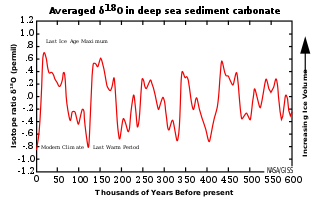
The 100,000-year problem of the Milankovitch theory of orbital forcing refers to a discrepancy between the reconstructed geologic temperature record and the reconstructed amount of incoming solar radiation, or insolation over the past 800,000 years. Due to variations in the Earth's orbit, the amount of insolation varies with periods of around 21,000, 40,000, 100,000, and 400,000 years. Variations in the amount of incident solar energy drive changes in the climate of the Earth, and are recognised as a key factor in the timing of initiation and termination of glaciations.
A season is a division of the year based on changes in weather, ecology, and the number of daylight hours in a given region. On Earth, seasons are the result of the axial parallelism of Earth's tilted orbit around the Sun. In temperate and polar regions, the seasons are marked by changes in the intensity of sunlight that reaches the Earth's surface, variations of which may cause animals to undergo hibernation or to migrate, and plants to be dormant. Various cultures define the number and nature of seasons based on regional variations, and as such there are a number of both modern and historical cultures whose number of seasons varies.
John E. Kutzbach was a climate scientist who pioneered the use of climate models to investigate the causes and effects of large changes of climate of the past.

The Penultimate Glacial Period (PGP) is the glacial period that occurred before the Last Glacial Period. The penultimate glacial period is officially unnamed just like the Last Glacial Period. The PGP lasted from ~194,000 years ago, to ~135,000 years ago, and was succeed by the Last Interglacial. The PGP also occurred during Marine Isotope Stage 6 (MIS6). At the glacial ages’ height, it is known to be the most extensive expansion of glaciers in the last 400,000 years over Eurasia, and could be the second or third coolest glacial period over the last 1,000,000 years, as shown by ice cores. Due to this, the global sea level dropped to between 92 and 150 metres below modern-day global mean sea level. The penultimate glacial period expanded ice sheets and shifted temperature zones worldwide, which had a variety of effects on the world's environment, and the organisms that lived in it. At its height, the penultimate glacial period was a more severe glaciation than the Last Glacial Maximum. The PGP covers the last period of the Saalian glaciation in Europe, called the Wolstonian Stage in Britain, and is equivalent to the Illinoian in North America.

The African humid period is a climate period in Africa during the late Pleistocene and Holocene geologic epochs, when northern Africa was wetter than today. The covering of much of the Sahara desert by grasses, trees and lakes was caused by changes in the Earth's axial tilt; changes in vegetation and dust in the Sahara which strengthened the African monsoon; and increased greenhouse gases. During the preceding Last Glacial Maximum, the Sahara contained extensive dune fields and was mostly uninhabited. It was much larger than today, and its lakes and rivers such as Lake Victoria and the White Nile were either dry or at low levels. The humid period began about 14,600–14,500 years ago at the end of Heinrich event 1, simultaneously to the Bølling–Allerød warming. Rivers and lakes such as Lake Chad formed or expanded, glaciers grew on Mount Kilimanjaro and the Sahara retreated. Two major dry fluctuations occurred; during the Younger Dryas and the short 8.2 kiloyear event. The African humid period ended 6,000–5,000 years ago during the Piora Oscillation cold period. While some evidence points to an end 5,500 years ago, in the Sahel, Arabia and East Africa, the end of the period appears to have taken place in several steps, such as the 4.2-kiloyear event.
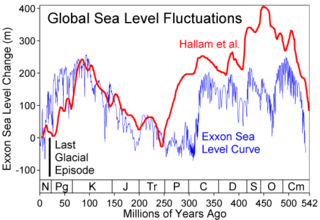
Paleohydrology, or palaeohydrology, is the scientific study of the movement, distribution, and quality of water on Earth during previous periods of its history. The discipline uses indirect evidence to infer changes in deposition rates, the existence of flooding, changes in sea levels, changes in groundwater levels and the erosion of rocks. It also deals with alterations in the floral and faunal assemblages which have come about in previous periods because of changes in hydrology.

The climate of Pluto concerns the atmospheric dynamics, weather, and long-term trends on the dwarf planet Pluto. Five climate zones are assigned on the dwarf planet: tropics, arctic, tropical arctic, diurnal, and polar. These climate zones are delineated based on astronomically defined boundaries or sub-solar latitudes, which are not associated with the atmospheric circulations on the dwarf planet. Charon, the largest moon of Pluto, is tidally locked with it, and thus has the same climate zone structure as Pluto itself.
References
- 1 2 Foley, Jonathan A.; Coe, Michael T.; Scheffer, Marten; Wang, Guiling (1 October 2003). "Regime Shifts in the Sahara and Sahel: Interactions between Ecological and Climatic Systems in Northern Africa". Ecosystems. 6 (6): 524–539. Bibcode:2003Ecosy...6..524F. CiteSeerX 10.1.1.533.5471 . doi:10.1007/s10021-002-0227-0. S2CID 12698952.
- 1 2 3 4 5 Larrasoaña, J. C.; Roberts, A. P.; Rohling, E. J.; Winklhofer, M.; Wehausen, R. (1 December 2003). "Three million years of monsoon variability over the northern Sahara". Climate Dynamics. 21 (7–8): 689–698. Bibcode:2003ClDy...21..689L. doi:10.1007/s00382-003-0355-z. S2CID 13570818.
- ↑ Bryan Lynn (January 6, 2019). "Study: Sahara Changed from Wet to Dry Every 20,000 Years". VOANews.com . Archived from the original on December 27, 2021. Retrieved January 7, 2019.
- ↑ Skonieczny, C. (2 January 2019). "Monsoon-driven Saharan dust variability over the past 240,000 years". Science Advances. 5 (1): eaav1887. Bibcode:2019SciA....5.1887S. doi:10.1126/sciadv.aav1887. PMC 6314818 . PMID 30613782.
- 1 2 3 4 5 6 7 8 9 10 Ruddiman, William F. (2001). Earth's Climate: Past and Future. New York, NY: W.H. Freeman and Company. ISBN 9780716737414.
- ↑ Kutzbach, J.E. (2 October 1981). "Monsoon Climate of the Early Holocene: Climate Experiment with the Earth's Orbital Parameters for 9000 Years Ago". Science. 214 (4516): 59–61. Bibcode:1981Sci...214...59K. doi:10.1126/science.214.4516.59. PMID 17802573. S2CID 10388125.
- ↑ Gasse, Françoise (January 2000). "Hydrological changes in the African tropics since the Last Glacial Maximum". Quaternary Science Reviews. 19 (1–5): 189–211. Bibcode:2000QSRv...19..189G. doi:10.1016/S0277-3791(99)00061-X.
- 1 2 3 Tuenter, E.; Weber, S.L.; Hilgen, F.J.; Lourens, L.J. (May 2003). "The response of the African summer monsoon to remote and local forcing due to precession and obliquity". Global and Planetary Change. 36 (4): 219–235. Bibcode:2003GPC....36..219T. doi:10.1016/S0921-8181(02)00196-0.
- ↑ Rossignol-Strick, Martine (7 July 1983). "African monsoons, an immediate climate response to orbital insolation". Nature. 304 (5921): 46–49. Bibcode:1983Natur.304...46R. doi:10.1038/304046a0. S2CID 4310252.
- ↑ Rohling, E.J.; Hilgen, F.J. (1991). "The Eastern Mediterranean Climate at times of Sapropel Formation: a Review". Geologie en Mijnbouw. 70: 253–264. hdl:1874/28551. ISSN 0016-7746.
- ↑ Rossignol-Strick, Martine; Nesteroff, Wladimir; Olive, Philippe; Vergnaud-Grazzini, Colette (14 January 1982). "After the deluge: Mediterranean stagnation and sapropel formation". Nature. 295 (5845): 105–110. Bibcode:1982Natur.295..105R. doi:10.1038/295105a0. S2CID 4237879.
- ↑ Rossignol-Strick, Martine (April 1985). "Mediterranean Quaternary sapropels, an immediate response of the African monsoon to variation of insolation". Palaeogeography, Palaeoclimatology, Palaeoecology. 49 (3–4): 237–263. Bibcode:1985PPP....49..237R. doi:10.1016/0031-0182(85)90056-2.
- 1 2 Drake, N.; Bristow, C. (1 September 2006). "Shorelines in the Sahara: geomorphological evidence for an enhanced monsoon from palaeolake Megachad". The Holocene. 16 (6): 901–911. Bibcode:2006Holoc..16..901D. doi:10.1191/0959683606hol981rr (inactive 2024-05-08). S2CID 128565786.
{{cite journal}}: CS1 maint: DOI inactive as of May 2024 (link) - ↑ Pokras, Edward M.; Mix, Alan C. (8 April 1987). "Earth's precession cycle and Quaternary climatic change in tropical Africa". Nature. 326 (6112): 486–487. Bibcode:1987Natur.326..486P. doi:10.1038/326486a0. S2CID 4256183.
- ↑ Gasse, Françoise; Stabell, Bjørg; Fourtanier, Elizabeth; van Iperen, Yolanda (20 January 2017). "Freshwater Diatom Influx in Intertropical Atlantic: Relationships with Continental Records from Africa". Quaternary Research. 32 (2): 229–243. Bibcode:1989QuRes..32..229G. doi:10.1016/0033-5894(89)90079-3. S2CID 129627113.
- ↑ McIntyre, Andrew; Ruddiman, William F.; Karlin, Karen; Mix, Alan C. (February 1989). "Surface water response of the equatorial Atlantic Ocean to orbital forcing". Paleoceanography. 4 (1): 19–55. Bibcode:1989PalOc...4...19M. doi:10.1029/PA004i001p00019.
- ↑ deMenocal, Peter; Ortiz, Joseph; Guilderson, Tom; Adkins, Jess; Sarnthein, Michael; Baker, Linda; Yarusinsky, Martha (January 2000). "Abrupt onset and termination of the African Humid Period: rapid climate responses to gradual insolation forcing". Quaternary Science Reviews. 19 (1–5): 347–361. Bibcode:2000QSRv...19..347D. doi:10.1016/S0277-3791(99)00081-5.
- ↑ Hoelzmann, P.; Jolly, D.; Harrison, S. P.; Laarif, F.; Bonnefille, R.; Pachur, H.-J. (March 1998). "Mid-Holocene land-surface conditions in northern Africa and the Arabian Peninsula: A data set for the analysis of biogeophysical feedbacks in the climate system". Global Biogeochemical Cycles. 12 (1): 35–51. Bibcode:1998GBioC..12...35H. doi: 10.1029/97GB02733 .
- 1 2 Drake, N. A.; Blench, R. M.; Armitage, S. J.; Bristow, C. S.; White, K. H. (27 December 2010). "Ancient watercourses and biogeography of the Sahara explain the peopling of the desert". Proceedings of the National Academy of Sciences. 108 (2): 458–462. Bibcode:2011PNAS..108..458D. doi: 10.1073/pnas.1012231108 . PMC 3021035 . PMID 21187416.
- ↑ Ganopolski, A. (19 June 1998). "The Influence of Vegetation-Atmosphere-Ocean Interaction on Climate During the Mid-Holocene" (PDF). Science. 280 (5371): 1916–1919. Bibcode:1998Sci...280.1916G. doi:10.1126/science.280.5371.1916. PMID 9632385. Archived (PDF) from the original on 27 March 2022. Retrieved 30 July 2023.